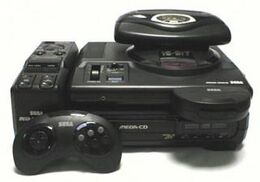Sega
From Sega Retro
Sega (セガ) is an international digital entertainment and media company currently headquartered in Ota, Tokyo, Japan. Founded in the mid-1940s, Sega experienced rapid growth in the 1980s and 1990s to become one of the dominant forces in its field. It remains to this day a major player in the worldwide video game industry, covering arcade, console, handheld, mobile and PC markets.
"Sega" is a trading name used by various iterations of the company since the early 1950s. Sega Enterprises was the longest corporate name, Sega held all the way up to July of 2000. In July of 2000, Sega became known as Sega Corporation. As of 2004, Sega operates under a collective holding company known as Sega Sammy Holdings. In April 2015, Sega Corporation was dropped in favor of multiple sub-divisions; Sega Games, handling the video game consumer business, Sega Interactive which deals with the development and production of arcade games, and Sega Entertainment, responsible for the running of commercial venues[1].
In practice, all divisions and groups within the company are generally refferred and known collectively as "Sega". Furthermore Sega's operations are typically referred to by region; Sega of Japan, Sega of America and Sega Europe being the main three.
Contents
History
Formation and early successes
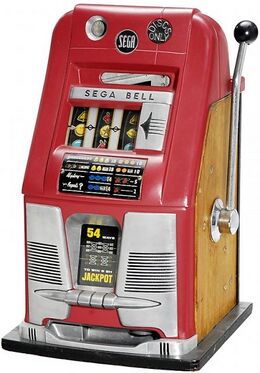
Sega claims to have been established in 1951 (and incorporated in 1960)[2], however in reality Sega's history begins with the establishment of "Service Games", Hawaii originating in 1945 when Irving Bromberg and his son, Martin Jerome Bromberg, formed a partnership with James L. Humpert to manufacture and distribute slot machines and other coin-operated devices, primarily to US personell stationed across Asia in the years after World War II. They called the partnership Service Games (i.e military service) and based their operation in Honolulu.
Irving Bromberg, the father, brought to the young company a reputation for being an innovator in coin-machine technology; as the founder of the Irving Bromberg Co. (established in 1933), he brought some of the first vending machines to Brooklyn, Boston and Washington, D.C. He also founded a business known as Standard Games Co. in Los Angeles, California, in 1934 for the civillian market. However, he was aging and his son assumed much of the management of Service Games. Bromley and Humpert were employed in the U.S. Navy Shipyard at Pearl Harbor during World War II, and had worked together in coin-operated enterprises that called upon the technical competence of the senior Bromberg.
The United States Congress of the Gambling Devices Transportation Act of 1951 banned slot machines on military bases within the territory of the United States, forcing Service Games to look into other avenues to market and sell their products. In February 1952, Bromley sent Richard Stewart, a Service Games salesman, and Raymond Lemaire, a mechanic, to Japan to promote and expand sales of Service Games machines on U.S. military reservations.
The result, Service Games, Japan, and over the next few years, a network of factories sprung up across South East Asia to cater for American troops stationed in the Orient. Service Games also began selling its machines in Europe, becoming one of the major players in the worldwide slot machine market.
By the early 1960s a series of money-making sell-offs left only the Japanese branch of Service Games still in operation, and in May 1960 had split into two entities, Nihon Goraku Bussan (distribution) and Nihon Kikai Seizo (manufacturing). The "Service Games" brand was no longer in use, but a condensed brand name was used by the latter - "Sega", first seen paired with the successful Sega 1000 jukebox.
The merge
The Korean war had seen American businessman and former Air Force officer David Rosen stationed in Japan, and having fallen in love with the country, returned in 1954 to establish Rosen Enterprises, Inc.[3]. Originally an art exporting business Rosen's company stumbled upon a surprise hit when it began to import coin-operated instant photo booths from America, tapping into the Japanese need for photographs as proof of identity. Talks with Bromley at Nihon Goraku Bussan proved fruitful, and the two sides merged in 1965, becoming Sega Enterprises Ltd. ("Sega borrowed from the Nihon Goraku Bussan side, and "Enterprises" coming from Rosen).
As Japanese living standards began to rise, Rosen moved into the arcade business, importing electro-mechanical games from Chicago. By 1961, the American arcade industry had declined, due to stagnation and lack of innovation from Chicago manufacturers. This led to Sega producing its own electro-mechanical arcade games, with engineer Hisashi Suzuki leading development, along with assistance from other Japanese engineers at Nihon Goraku Bussan.[4][5]
the Chicago arcade industry declined,
Soon Rosen had a presence in 200 Japanese arcades, and he sought out competitors in the interests of merging. Talks with Bromley at Nihon Goraku Bussan proved fruitful, and the two sides became Sega Enterprises Ltd. in 1965 ("Sega" borrowed from the Nihon Goraku Bussan side, and "Enterprises" coming from Rosen).
Gulf+Western

Equipped with brand recognition, strong distribution channels and a large arcade presence, Sega's import business boomed, and soon found itself producing its own games, starting with the 1966 smash hit, Periscope. Proving that a non-American company could make gains in the coin-op industry, Sega was acquired on May 3, 1969 by media conglomerate Gulf+Western. This opened the door for Sega to enter other arenas, importing both American-made pinball tables (before manufacturing its own starting with Winner in 1972) and Rock-Ola jukeboxes.
Being a company involved in the business of entertainment, it was only a matter of time before Sega would look into video games. Seeing the success of Atari's Pong, Sega branched out into video game importing and later development, allying themselves with Gremlin Industries in North America. As electro-mechanical games were displaced, Sega began to make a name for itself through games such as Turbo and Zaxxon, as well as through distributing Frogger in the States.
Seeing the potential, 1984 saw Rosen and a group of outside investors (including Hayao Nakayama, Shoichiro Irimajiri and the chairman of CSK, Isao Okawa) bought back Sega, and as an independent company once more, continued to expand rapidly into the 1980s.
Arcades
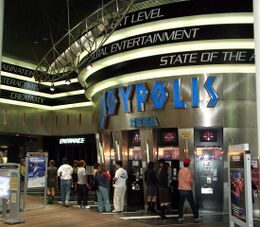
Sega has had a strong presence in the arcade industry since the 1960s. It initially produced electro-mechanical games in the 1960s and 1970s, before moving on to arcade video games in the 1970s.
In the 1980s and 1990s arcade scene, Sega went from strength to strength, leading the market with hits such as Space Harrier, OutRun and After Burner before becoming a driving force behind 3D gaming in Virtua Racing and the massively successful Virtua Fighter. It also saw success in other areas - its UFO Catcher line of crane games continues to this day. In the 21th century its networked arcade franchises such as World Club Champion Football and Border Break remain unrivalled. Western arcades began to declne with the arrival of home consoles. However in Japan, Sega's eleborate cabinets kept costumers interrested in going to arcades with experiences not avaible at home.[6]
Since the 1960s, Sega has been opening its own arcade centres, peaking in the 1990s when hundreds of Hi-Tech Land Sega, Sega World and Club Sega venues were spread across Japan. It also operates its own indoor Joypolis theme parks, and has claims to resorts and restaurants. Sega arcades have also operated (albeit at a much smaller scale) in the US and across Europe, peaking with its line of GameWorks arcades in the early 2000s.
As arcades began to decline in the late 1990s, so too did Sega focus in the arcade market. Forced to innovate to keep customers, Sega's sees itself in the position of keeping the Japanese arcade market alive. Equally many of its arcade hits such as Daytona USA and Sega Rally Championship remain in active service worlwide more than twenty years after release.
Video game consoles
1983 marked a turning point for Sega. after it entered an increasingly crowded Japanese video game console and home computer market with its latest invention, the SG-1000 (and computer counterpart, the SC-3000). Between 1983 and 1985 many significant recruitments were made for this new "consumer products" division that would shape the company's image in the decades that followed, and while the SG-1000 was unable to unseat Nintendo and their Family Computer, support from its arcade business kept them firmly in the game. It was also one of the few Japanese systems to make it across the border, making a limited mark on Australia, New Zealand, France, Italy, Sweden and parts of Asia.
Next came the Sega Mark III in 1985, a more competitive system ready to take on Nintendo coupled with a plan to launch overseas. In its redesigned Sega Master System form, Sega started to become a household name, appearing in various guises not only in Japan, but across North America, Europe and Brazil. While a distant second in Japan and the US, the Master System triumphed in smaller markets, not least to its unique ties to Sega's industry-leading arcade divisions.
Sega entered perhaps its most successful period in the western market with the 16-bit Sega Mega Drive in 1988, capturing not only the lion's share of the market in Europe, but regularly unseating Nintendo's dominance in the US. The invention of company mascot Sonic the Hedgehog and his ground-breaking video game revolutionised the industry at large, but did little to impress its Japanese homeland. Extensions in the Sega Mega-CD and Sega 32X struggled to gain traction, but the company saw reasonable success through it's full colour portable handheld system, the Sega Game Gear.
The early 1990s also saw Sega as a driving force behind video game content regulation, following the North American controversies surrounding Night Trap and Mortal Kombat. Sega's contribution in the US was the Videogame Rating Council - a system to highlight potentially inapprorpate games for younger children. Sega of America were at the forefront of this debate, and Tom Kalinske was happy to accept the eventual establishment of the Entertainment Software Rating Board, which has been the de-facto regulator of North American video games since 1994. Elsewhere Sega pushed its own ratings systems, and despite the creation of the Japanese Computer Entertainment Rating Organization 2002, continues to add extra warnings (entirely of its own accord) for violent content.
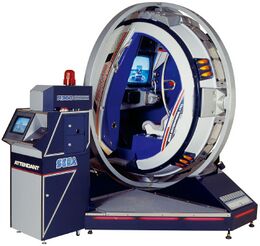
With the 32-bit Sega Saturn, Sega's console fortunes were reversed in Japan, unfortunately at the expense of everywhere else. While initially strong, the Saturn tore apart the firm in the US, and led to the company's first recorded loss for the year ending March 1998.
Attempts at revival were made with the internet-focused Sega Dreamcast the following November, but despite a strong selection of games and a devoted fanbase, the company found itself unwilling and unable to compete against its peers in the PlayStation 2, Xbox and Nintendo GameCube. In January 2001 the firm abandoned its home console ambitions, focusing instead as a third-party developer and publisher.
Merger with Sammy
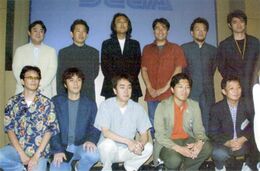
The demise of the Dreamcast saw Sega focus its efforts as a third-party video game manufacturer, aiming to be the largest of its kind by March 2004[7]. But financial troubles eventually saw it merged with pachinko-firm Sammy, leading it to operate under a collective Sega Sammy Holdings holding company.
In the third party era, Sega has had little mass market success in the western market, with the exception of the long-standing Sonic The Hedgehog franchise which has endured wide flunctations of quality. On the flip-end, Sega has been successfull at carving out niches with the western PC strategy market, as well mobile and arcade titles aimed at Asian audiences. Recently Sega also made an unpreecented move in completly replacing their former american branch in the San Francisco area, with that of video game localization experts Atlus USA.
External links
References
- ↑ File:IR EN 2015-02-12 3.pdf
- ↑ File:AnnualReport2001 English.pdf, page 3
- ↑ File:NextGeneration US 24.pdf, page 9
- ↑ https://archive.org/stream/NextGeneration24Dec1996/Next_Generation_24_Dec_1996#page/n10/mode/1up
- ↑ http://magweasel.com/2011/04/07/the-loons-who-developed-arcade-electromechanical-games/
- ↑ http://segabits.com/blog/2016/08/25/sega-retrospective-deeper-arcade-game-oxymoron-became-one-segas-pillars/
- ↑ File:Edge UK 104.pdf, page 7
| Early Sega | |||||||||||||||||||||||||||||||||||||||
| 45 | 46 | 47 | 48 | 49 | 50 | 51 | 52 | 53 | 54 | 55 | 56 | 57 | 58 | 59 | 60 | 61 | 62 | 63 | 64 | 65 | 66 | 67 | 68 | 69 | 70 | 71 | 72 | 73 | 74 | 75 | 76 | 77 | 78 | 79 | 80 | 81 | 82 | 83 | 84 |
|---|---|---|---|---|---|---|---|---|---|---|---|---|---|---|---|---|---|---|---|---|---|---|---|---|---|---|---|---|---|---|---|---|---|---|---|---|---|---|---|
| Service Games | Gulf+Western | ||||||||||||||||||||||||||||||||||||||
| Service Games, Hawaii & Nevada & Japan | Nihon Goraku Bussan & Nihon Kikai Seizou | Sega Enterprises, Inc. | |||||||||||||||||||||||||||||||||||||
| Sega Enterprises, Ltd. | Sega Ltd. & Gremlin | Sega Ltd. | |||||||||||||||||||||||||||||||||||||
| Timeline of Sega of Japan research and development divisions |
|---|
|
83
84
85
86
87
88
89
90
91
92
93
94
95
96
97
98
99
00
01
02
03
04
05
06
07
08
09
10
11
12
13
14
15
16
17
18
19
20
21
22
|

